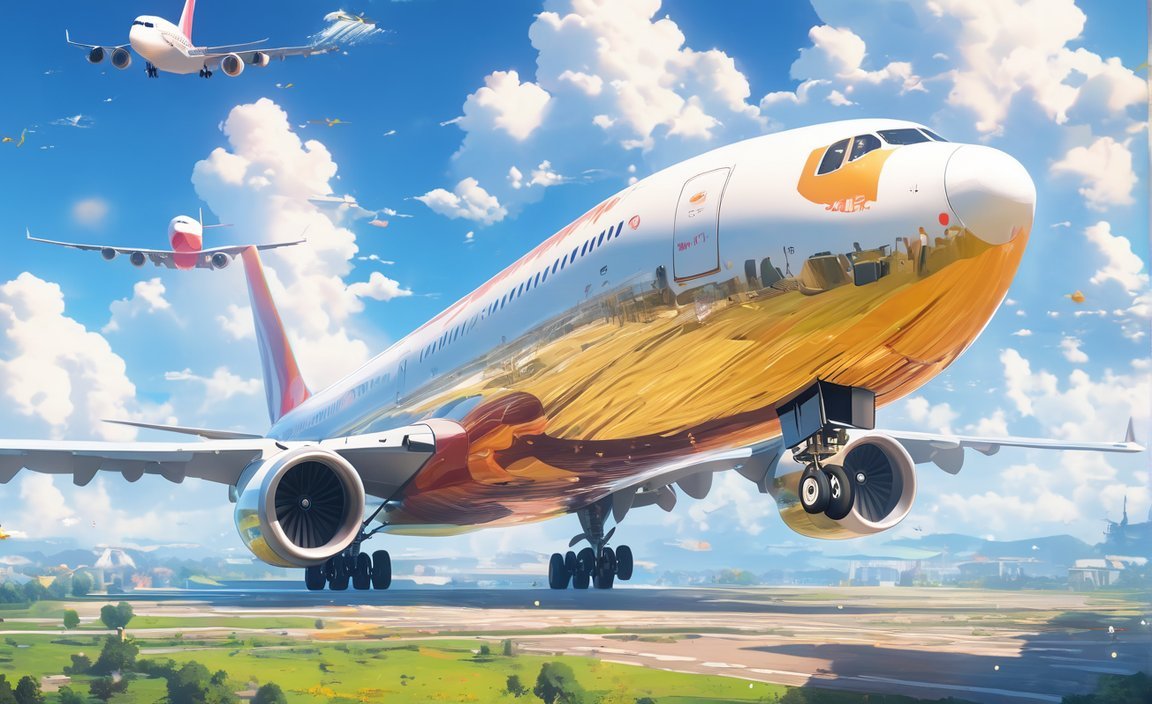In the modern era of interconnectedness, air transportation has emerged as a cornerstone of global mobility, revolutionizing the way we traverse vast distances and experience diverse cultures. While often perceived as a luxury mode of travel, air transportation holds immense significance, offering a plethora of advantages that have transformed our world.
High Speed: Connecting the World at a Brisk Pace

In the realm of transportation, air travel reigns supreme in terms of speed. Unlike land or sea travel, which are often restricted by geographical barriers and infrastructural limitations, air transportation soars above these constraints, allowing us to traverse continents and oceans in a matter of hours. This remarkable speed has revolutionized global connectivity, transforming the way we conduct business, seek medical attention, and transport perishable goods.
Bridging Global Distances for Efficient Business Travel
In today’s interconnected world, business success hinges on the ability to connect with clients and partners across the globe. Air transportation facilitates this seamless connectivity, enabling business travelers to attend meetings, conferences, and negotiations in far-flung destinations with remarkable efficiency. The ability to cover vast distances quickly allows for more face-to-face interactions, fostering stronger business relationships and driving economic growth.
Responding to Urgent Medical Needs with Pioneering Speed
In times of medical emergencies, air transportation emerges as a lifeline, providing rapid access to specialized care and treatment. When every second counts, air ambulances can transport critically ill patients to renowned medical centers with unparalleled speed, bridging the gap between remote locations and advanced medical facilities. This swiftness in patient transport can make the difference between life and death.
Ensuring Perishable Goods Reach Their Destination Fresh and Fast
The world of perishable goods, such as fresh produce, pharmaceuticals, and delicate electronics, demands a transportation system that can deliver them quickly and intact. Air transportation fulfills this need, providing a secure and temperature-controlled environment that ensures these goods arrive at their destinations fresh and in pristine condition. This rapid delivery not only maintains the quality of perishable goods but also minimizes supply chain disruptions.
Quick Service: Punctuality and Efficiency in the Skies
In the modern era, where time is a precious commodity, air travel has become synonymous with punctuality and efficiency. Unlike land or sea travel, which can be plagued by delays due to unforeseen circumstances, air transportation has established a reputation for delivering passengers to their destinations on time. This remarkable reliability is the culmination of sophisticated air traffic control systems, advanced aircraft technology, and well-established operational procedures.
Orchestrating Seamless Travel with Advanced Air Traffic Control
At the heart of air travel’s punctuality lies a complex yet meticulously orchestrated system of air traffic control. This intricate network of air traffic controllers, utilizing cutting-edge technology and sophisticated communication protocols, guides aircraft safely and efficiently through the skies. They monitor flight paths, coordinate airspace usage, and ensure that aircraft maintain safe separation distances, preventing delays and ensuring a smooth flow of air traffic.
Harnessing Technological Advancements for Enhanced Efficiency
Modern aircraft are marvels of engineering, equipped with advanced technology that contributes significantly to punctuality and efficiency. Automated flight systems, sophisticated navigation equipment, and precise weather-forecasting tools enable pilots to operate aircraft with utmost precision and optimize flight paths, minimizing delays caused by adverse weather conditions.
Streamlined Operational Procedures for a Dependable Travel Experience
The aviation industry adheres to stringent operational procedures that further enhance the reliability of air travel. These procedures encompass everything from thorough pre-flight aircraft inspections and meticulous crew training to well-defined passenger boarding and disembarking processes. By adhering to these established protocols, airlines minimize potential delays and ensure a smooth and efficient travel experience for passengers.
In essence, the punctuality and efficiency of air travel are not merely coincidences but rather the result of a concerted effort involving sophisticated technology, meticulous planning, and adherence to stringent operational procedures. This commitment to reliability has transformed air transportation into the preferred mode of travel for those who value their time and seek a seamless travel experience.
Global Reach: Spanning the Globe without Boundaries
In the vast expanse of our planet, air transportation stands as a testament to human ingenuity, bridging continents and cultures with an unparalleled global reach. Unlike land-based transportation, which is often confined by geographical barriers and infrastructural limitations, air travel soars above these constraints, connecting even the most remote corners of the world with seamless efficiency. This unprecedented global reach has revolutionized travel, commerce, and communication, fostering a truly interconnected world.
Unveiling a Network that Connects the Ends of the Earth
The global air transportation network is a marvel of connectivity, spanning over 200 countries and territories and encompassing over 45,000 airports. This intricate network of air routes enables travelers to reach almost every destination imaginable, from bustling metropolises to secluded island paradises. No longer are physical barriers such as vast oceans, towering mountains, or dense forests impediments to travel. Air travel transcends these boundaries, connecting people and cultures in a way that was once unimaginable.
Facilitating Global Commerce: A Gateway to Economic Prosperity
Air transportation serves as a vital engine of global commerce, enabling the seamless movement of goods and services across borders. Businesses rely on airfreight to transport high-value, time-sensitive goods, such as electronics, pharmaceuticals, and perishable items, ensuring efficient supply chains and fostering economic growth. Moreover, air travel facilitates face-to-face interactions between business partners and investors, driving international trade and promoting global economic prosperity.
Bridging Cultural Divides: Fostering Understanding and Cooperation
Air transportation has played a pivotal role in bridging cultural divides and promoting global understanding. By facilitating travel and cultural exchange, air travel has opened up new avenues for communication, collaboration, and mutual appreciation of diverse cultures. People from all corners of the world can now experience different cultures firsthand, fostering empathy, tolerance, and a sense of global citizenship. This cultural exchange has undoubtedly contributed to a more interconnected and harmonious world.
In essence, the global reach of air transportation is not merely a logistical achievement; it is a transformative force that has reshaped our world. By connecting people, cultures, and economies, air travel has fostered global understanding, economic prosperity, and a sense of shared humanity. As we continue to innovate and expand the global air transportation network, we can look forward to an even more interconnected future, where the boundaries of our world continue to dissolve into a tapestry of shared experiences and understanding.
High Standard of Security: Safeguarding Lives and Valuables
In the realm of transportation, air travel stands out as a pinnacle of safety, prioritizing the well-being of passengers and their belongings. Unlike land or sea travel, which may encounter unpredictable hazards, air transportation adheres to stringent safety protocols, ensuring that every flight operates with the utmost regard for safety. This unwavering commitment to safety is evident in the rigorous aircraft maintenance, comprehensive training for pilots and crew, and advanced security measures that are implemented at every stage of the air travel experience.
Rigorous Aircraft Maintenance: A Pillar of Safety
At the heart of air travel safety lies a meticulous approach to aircraft maintenance. Airlines adhere to strict maintenance schedules, utilizing state-of-the-art technology and highly trained technicians to inspect and maintain every component of an aircraft. From inspecting engines and structural integrity to ensuring the proper functioning of avionics and safety systems, no detail is overlooked. This rigorous maintenance regimen ensures that aircraft are in peak condition, minimizing the risk of mechanical failures and upholding the highest standards of safety.
Comprehensive Pilot and Crew Training: Cultivating Expertise
The safety of an airliner rests not only on the aircraft itself but also on the expertise of its pilots and crew. Airline pilots undergo rigorous training programs, mastering complex flight procedures, navigation techniques, and emergency response protocols. Similarly, flight attendants are trained to handle a wide range of scenarios, from providing emergency assistance to ensuring passenger comfort and safety. This comprehensive training instills in pilots and crew the knowledge and skills necessary to navigate the skies with confidence and handle any situation that may arise.
Advanced Security Measures: Protecting Passengers and Belongings
Aviation security measures have evolved to meet the ever-changing threats to passenger safety. From sophisticated screening checkpoints to enhanced cockpit security protocols, airlines and airport authorities employ a multi-layered approach to safeguard passengers and their belongings. These measures include passenger and baggage screening, stringent access controls to restricted areas, and the deployment of specialized security personnel. This unwavering commitment to security ensures that air travel remains one of the safest modes of transportation.
In essence, the high standard of security in air transportation is not merely a precaution; it is a testament to the industry’s unwavering commitment to the safety of its passengers and crew. By adhering to rigorous maintenance practices, investing in comprehensive training, and implementing advanced security measures, air transportation has established itself as a safe, reliable, and secure mode of travel, fostering confidence and peace of mind among travelers worldwide.
Natural Route: Navigating the Skies without Obstructions
In the realm of transportation, air travel stands apart for its ability to traverse the skies unimpeded by terrestrial obstacles. Unlike land-based transportation, which is often constrained by geographical barriers and infrastructural limitations, aircraft can soar above these constraints, charting a direct course to their destinations without the need for detours or diversions. This unique “natural route” capability not only saves time and fuel but also opens up a world of possibilities for connecting remote locations and transporting goods efficiently.
Unveiling a Direct Path to Distant Destinations
The ability of aircraft to navigate directly to their destinations, unhindered by land-based obstacles, is a fundamental advantage of air travel. Unlike land or sea travel, which must navigate around mountains, rivers, and dense forests, aircraft can fly directly over these barriers, saving significant time and fuel. This direct routing capability is particularly advantageous for long-haul flights, allowing passengers and cargo to reach their destinations more quickly and efficiently.
Bridging Remote Locations: Connecting the Unconnected
The natural route capability of air travel has revolutionized the way we connect remote locations. In regions where land-based transportation is challenging or impractical, air travel has emerged as a lifeline, providing essential access to medical care, education, and essential goods. This ability to bypass physical barriers has transformed the lives of people in remote areas, fostering economic development, improving access to healthcare, and facilitating cultural exchange.
Harnessing the Efficiency of Direct Routing for Cost-Effective Transportation
The direct routing capability of air travel not only saves time but also contributes to fuel efficiency. By avoiding unnecessary detours and diversions, aircraft can optimize their flight paths, reducing fuel consumption and minimizing environmental impact. This efficiency in fuel usage is particularly important for cargo airlines, as it translates into lower transportation costs and a more sustainable approach to freight movement.
In essence, the natural route advantage of air travel is not merely a matter of convenience; it is a transformative force that has revolutionized connectivity, accessibility, and efficiency in transportation. By enabling direct travel over vast distances and bypassing land-based obstacles, air travel has connected remote communities, facilitated global commerce, and contributed to a more interconnected world. As we continue to innovate in aviation technology, we can look forward to even more efficient and sustainable air travel solutions, further unlocking the potential of this remarkable mode of transportation.
Strategic Importance: A Lifeline for Nations

Air transportation stands as a cornerstone of national security and economic development, playing a pivotal role in safeguarding nations and propelling their growth. Its strategic importance extends far beyond passenger travel, encompassing a wide spectrum of critical functions that contribute to the well-being and prosperity of countries worldwide.
A Bastion of National Security: Rapid Deployment and Effective Response
In the realm of national security, air transportation serves as an indispensable asset, enabling rapid troop deployment, medical aid delivery, and disaster relief operations. In times of crisis, airlift capabilities allow nations to swiftly mobilize their armed forces, deploy humanitarian assistance, and respond effectively to natural disasters or emergencies. The ability to transport troops, equipment, and supplies to remote locations with unparalleled speed is crucial for maintaining national security and protecting the interests of a country’s citizens.
A Lifeline for Medical Aid: Delivering Hope and Saving Lives
When medical emergencies arise, air transportation emerges as a lifeline, facilitating the swift delivery of critical medical care and supplies to remote regions or areas affected by disasters. Medical evacuation flights enable the transport of critically ill patients to specialized medical facilities, while air cargo services can deliver life-saving medicines, vaccines, and medical equipment to areas in need. This rapid access to medical care can make the difference between life and death, underscoring the strategic importance of air transportation in the healthcare sector.
A Catalyst for Economic Development: Connecting Markets and Fostering Growth
Air transportation serves as a vital conduit for international trade and tourism, fostering economic growth and prosperity across nations. It connects businesses and consumers worldwide, enabling the seamless flow of goods, services, and capital. International air travel facilitates business meetings, trade negotiations, and cultural exchanges, stimulating economic activity and fostering global partnerships. Moreover, tourism, heavily reliant on air travel, brings in foreign investment, creates jobs, and generates revenue for local communities.
In essence, the strategic importance of air transportation extends far beyond the realm of passenger travel. It is an indispensable tool for national security, a lifeline for medical aid, and a catalyst for economic development. By enabling rapid troop deployment, medical aid delivery, and the seamless flow of goods and services, air transportation plays a pivotal role in safeguarding nations, promoting global health, and driving economic prosperity.
Easy Transport of Costly and Light Goods: A Lifeline for Valuable Cargo
In the realm of transportation, airfreight has emerged as a lifeline for high-value, lightweight goods, offering a convenient, secure, and efficient means to transport these delicate items to their destinations quickly and in pristine condition. Unlike land or sea transport, which may expose goods to damage, delays, or theft, airfreight provides a controlled and secure environment, ensuring that valuable electronics, pharmaceuticals, and perishable items reach their intended recipients in top condition.
Ensuring the Swift Delivery of Delicate Electronics
The electronics industry relies heavily on airfreight to transport its products, from smartphones and laptops to sophisticated medical equipment. Airfreight’s speed and efficiency are crucial for ensuring that these time-sensitive items reach retailers and consumers quickly, minimizing the risk of obsolescence or delayed market entry. The controlled environment of air cargo holds allows electronics to be transported without exposure to extreme temperatures, humidity, or physical damage, preserving their quality and functionality.
Safeguarding Pharmaceuticals with Unmatched Precision
The pharmaceutical industry entrusts airfreight with the critical task of transporting life-saving medications and vaccines. Airfreight’s ability to maintain precise temperature and humidity control is essential for preserving the integrity of these delicate products. Specialized air cargo containers and meticulously regulated handling procedures ensure that pharmaceuticals reach their destinations without compromising their efficacy or safety.
Preserving Perishable Goods with Unparalleled Freshness
Airfreight has revolutionized the transportation of perishable goods, such as fresh produce, seafood, and flowers. By minimizing transportation time, airfreight ensures that these delicate items retain their freshness, flavor, and nutritional value. Moreover, airfreight’s secure and temperature-controlled environment prevents spoilage and contamination, ensuring that consumers enjoy the highest quality produce and seafood.
In essence, the convenience, security, and efficiency of airfreight have transformed the transportation of high-value, lightweight goods. By providing a rapid and controlled environment, airfreight has become the preferred mode of transport for electronics, pharmaceuticals, and perishable items, ensuring that these valuable goods reach their destinations in pristine condition, contributing to global commerce, medical advancements, and culinary experiences.
Suitable for Long Distances: Bridging the Globe with Unparalleled Efficiency
In the realm of transportation, air travel stands out as the pinnacle of efficiency for long-distance journeys. Unlike land or sea travel, which can be constrained by geographical barriers and infrastructural limitations, aircraft can soar above these constraints, traversing vast distances in a matter of hours. This remarkable ability to bridge the globe with unparalleled efficiency has transformed long-haul travel, making it faster, more convenient, and more accessible than ever before.
Conquering Vast Distances with Unmatched Speed
At the heart of air travel’s suitability for long distances lies its unmatched speed. While land or sea travel may require days or even weeks to cover vast distances, air travel accomplishes this task in a matter of hours. This remarkable speed is attributed to the high cruising speeds of modern aircraft, which can reach up to 600 miles per hour. This ability to cover vast distances quickly translates into significant time savings for travelers, particularly for those embarking on long-haul journeys.
A Gateway to Global Connections: Connecting Distant Destinations
The efficiency of air travel in connecting distant locations has revolutionized global connectivity. Air transportation has enabled seamless travel between continents, fostering cultural exchange, international business partnerships, and tourism. It has opened up remote regions to the world, facilitating economic development and providing access to essential goods and services. This global connectivity has transformed our world, making it more interconnected, interdependent, and accessible.
A Catalyst for Global Commerce: Enabling Efficient Freight Movement
Air transportation plays a pivotal role in global commerce, enabling the efficient movement of goods across vast distances. Airlines have established extensive cargo networks, connecting major economic hubs worldwide. This enables businesses to transport high-value, time-sensitive goods, such as electronics, pharmaceuticals, and perishable items, quickly and securely. The efficiency of airfreight has streamlined supply chains, reduced delivery times, and fostered global economic growth.
In essence, the suitability of air transportation for long distances extends far beyond mere passenger travel. It has transformed global connectivity, facilitated international business, and revolutionized the movement of goods. By bridging vast distances with unparalleled efficiency, air travel has made the world a smaller, more interconnected place, fostering understanding, collaboration, and economic prosperity.
Reliable Transportation: A Beacon of Punctuality in a Chaotic World
In the realm of transportation, air travel stands as a beacon of punctuality and reliability amidst a world often plagued by disruptions and delays. Unlike land-based transportation, which is susceptible to the whims of weather, the constraints of traffic congestion, and the fragility of infrastructure, air transportation maintains a consistent and dependable schedule, earning a reputation for its unwavering reliability. This resilience in the face of unforeseen challenges has instilled confidence in travelers and businesses worldwide, making air travel the preferred mode of transportation for those who value punctuality and dependability.
Weathering the Storms with Unwavering Reliability
While land and sea travel often fall victim to the capricious nature of weather, air transportation has established a remarkable resilience to meteorological disruptions. Advanced weather forecasting systems, sophisticated aircraft avionics, and rigorous pilot training enable aircraft to navigate safely and efficiently through turbulent weather conditions. This ability to operate in challenging weather conditions ensures that flight schedules are maintained, minimizing delays and cancellations for passengers and cargo.
Navigating Traffic Congestion with Unparalleled Efficiency
Unlike land-based transportation, which is often plagued by traffic congestion and gridlock, air travel soars above these constraints, navigating the skies with unparalleled efficiency. Air traffic control systems, utilizing cutting-edge technology and meticulous coordination, orchestrate the seamless movement of aircraft, ensuring that flight paths are optimized and airspace is utilized effectively. This ability to bypass traffic congestion translates into consistent flight times and reliable schedules for passengers.
Adapting to Infrastructure Disruptions with Remarkable Resilience
While land and sea transportation networks are often vulnerable to infrastructure disruptions caused by natural disasters or accidents, air transportation possesses an inherent resilience. The ability of aircraft to take off and land on a variety of surfaces, including temporary runways and remote locations, provides flexibility in the face of infrastructure disruptions. Moreover, airlines maintain contingency plans and diversion airports to ensure that flights can be rerouted if necessary, minimizing disruptions for passengers.
In essence, the reliability of air transportation is not merely a matter of convenience; it is a testament to the industry’s unwavering commitment to punctuality and dependability. By investing in advanced technology, adhering to rigorous safety protocols, and cultivating a culture of resilience, air transportation has established itself as a reliable mode of travel, fostering trust and confidence among travelers and businesses worldwide. As we continue to innovate and enhance air traffic management systems, we can look forward to even greater levels of punctuality and reliability, further solidifying air travel’s position as the most dependable mode of transportation.
Independent from Physical Disturbance: A Pathway to Untamed Territories
In the realm of transportation, air travel stands as a testament to human ingenuity, traversing the skies unhindered by the physical barriers that often constrain land and sea travel. Unlike land-based transportation, which is confined by mountains, rivers, and dense forests, air transportation soars above these obstacles, charting a direct course to destinations that would otherwise be difficult or impossible to reach. This independence from physical disturbances allows for efficient travel over challenging terrains, connecting remote regions that were once isolated, fostering economic development, cultural exchange, and scientific exploration.
Bridging Rugged Terrain with Unparalleled Efficiency
The ability of air transportation to operate independently of physical disturbances has transformed the way we connect remote and challenging regions. Mountains, once formidable barriers to travel, are now merely contours to be traversed by aircraft. Dense forests and vast expanses of water, once insurmountable obstacles, are now mere landscapes beneath the wings of airplanes. This remarkable ability to bypass physical barriers has enabled the transportation of essential goods and services to remote communities, facilitating access to healthcare, education, and economic opportunities.
Connecting Remote Communities: A Lifeline for the Isolated
Air transportation has emerged as a lifeline for remote communities, providing a vital connection to the outside world. In regions where land-based transportation is impractical or nonexistent, air travel has become the primary means of accessing essential goods, services, and medical care. This connectivity has transformed the lives of people in remote areas, improving their quality of life, fostering economic development, and strengthening cultural ties with the wider world.
Unveiling Hidden Treasures: A Gateway to Scientific Exploration
The independence of air transportation from physical disturbances has opened doors to scientific exploration in remote and challenging environments. Researchers can now access previously inaccessible regions, conducting studies on biodiversity, climate change, and geological formations. This ability to navigate over mountains, glaciers, and rainforests has provided invaluable insights into the natural world, expanding our understanding of the planet’s diverse ecosystems and fragile environments.
In essence, the ability of air transportation to operate independently from physical disturbances has not merely revolutionized travel; it has transformed our relationship with the planet. By bridging remote regions, connecting isolated communities, and enabling scientific exploration, air travel has fostered global understanding, economic development, and a deeper appreciation for the natural world. As we continue to innovate in aviation technology, we can look forward to even greater freedom from physical constraints, further expanding the reach and impact of air transportation.
In conclusion, air transportation stands as a testament to human ingenuity, offering a multitude of advantages that have transformed the world we live in. Its speed, reliability, and global reach have revolutionized travel, commerce, and communication, making it an indispensable force in today’s interconnected world. As we continue to innovate and refine aviation technology, the future of air transportation promises even greater heights, connecting us in ways we can only begin to imagine.
- To discover the 10 best ways to reduce air pollution, visit this page.
- Explore the 10 biggest environmental problems by clicking here.
- Uncover the 10 causes of noise pollution by following this link.
FAQ
Q1: What are the key advantages of air transportation?
A1: Air transportation offers a multitude of advantages, including high speed, global reach, high standard of security, and the ability to transport costly and light goods efficiently. It is also suitable for long distances and is relatively independent from physical disturbances such as mountains, rivers, and dense forests.
Q2: How does air transportation provide high speed travel?
A2: Air transportation is the fastest mode of travel, allowing passengers and cargo to reach their destinations quickly and efficiently. Aircraft can travel at speeds of up to 600 miles per hour, significantly reducing travel time compared to land or sea travel.
Q3: In what ways does air transportation offer global reach?
A4: Air transportation has an unparalleled global reach, connecting over 200 countries and territories and encompassing over 45,000 airports. This intricate network of air routes enables travelers to reach almost every destination imaginable, from bustling metropolises to secluded island paradises.
Q4: What measures are in place to ensure the high standard of security in air transportation?
A5: The aviation industry adheres to stringent safety protocols, making air travel one of the safest modes of transportation. Rigorous aircraft maintenance, comprehensive training for pilots and crew, and advanced security measures ensure the well-being of passengers and their belongings.
Q5: How does air transportation benefit the transportation of costly and light goods?
A6: Airfreight offers a convenient and secure means of transporting high-value, lightweight goods, such as electronics, pharmaceuticals, and perishable items. The speed and efficiency of air transportation ensure that these goods reach their destinations quickly and in pristine condition.











